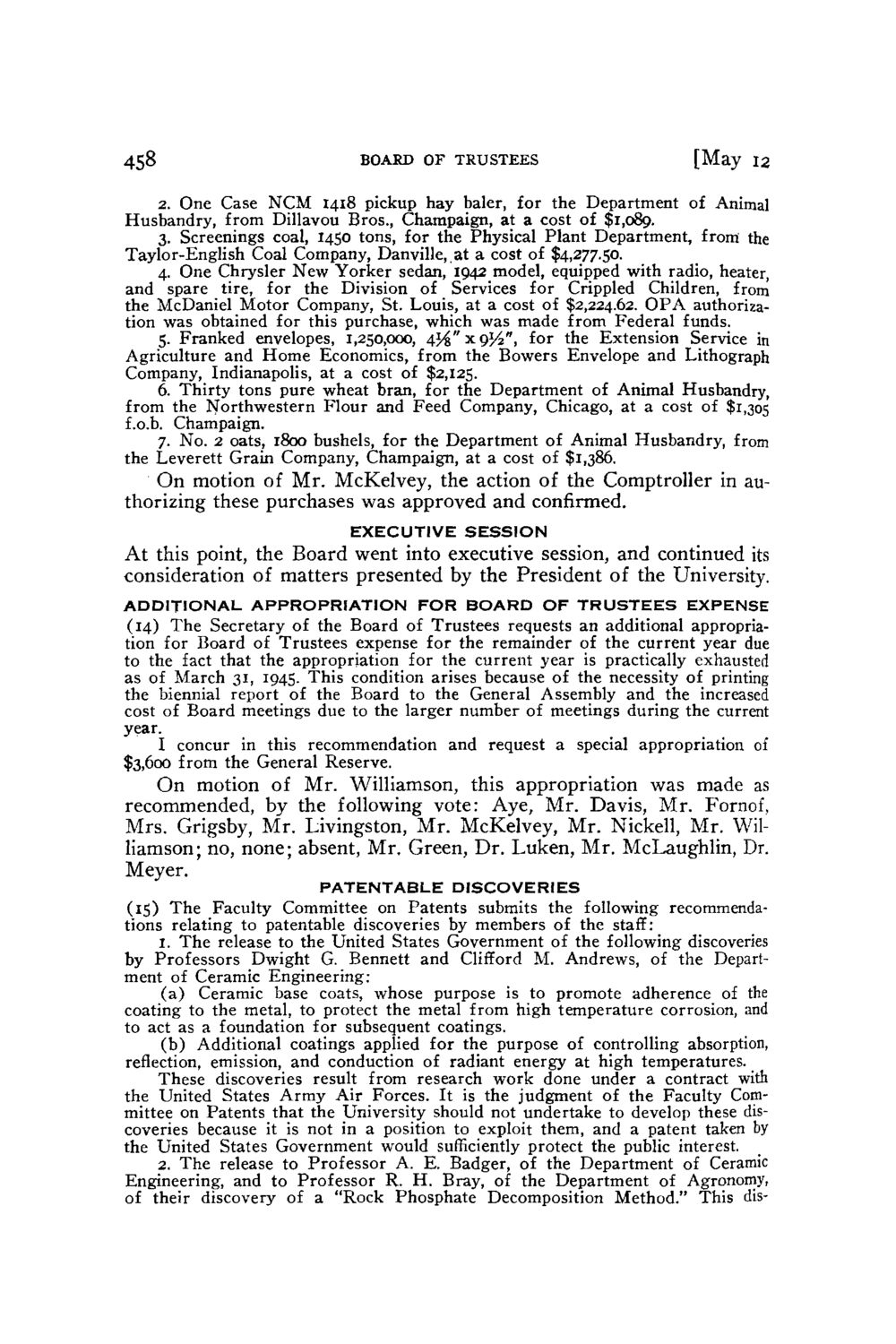| |
| |
Caption: Board of Trustees Minutes - 1946
This is a reduced-resolution page image for fast online browsing.

EXTRACTED TEXT FROM PAGE:
458 BOARD OF TRUSTEES [May 12 2. One Case NCM 1418 pickup hay baler, for the Department of Animal Husbandry, from Dillavou Bros., Champaign, at a cost of $1,089. 3. Screenings coal, 1450 tons, for the Physical Plant Department, from the Taylor-English Coal Company, Danville, at a cost of $4,277.50. 4. One Chrysler New Yorker sedan, 1942 model, equipped with radio, heater, and spare tire, for the Division of Services for Crippled Children, from the McDaniel Motor Company, St. Louis, at a cost of $2,224.62. O P A authorization was obtained for this purchase, which was made from Federal funds. 5. Franked envelopes, 1,250,000, 4^6" x 9 ^ " , for the Extension Service in Agriculture and H o m e Economics, from the Bowers Envelope and Lithograph Company, Indianapolis, at a cost of $2,125. 6. Thirty tons pure wheat bran, for the Department of Animal Husbandry, from the Northwestern Flour and Feed Company, Chicago, at a cost of $1,305 f.o.b. Champaign. 7. No. 2 oats, 1800 bushels, for the Department of Animal Husbandry, from the Leverett Grain Company, Champaign, at a cost of $1,386. On motion of Mr. McKelvey, the action of the Comptroller in authorizing these purchases was approved and confirmed. EXECUTIVE SESSION At this point, the Board went into executive session, and continued its consideration of matters presented by the President of the University. ADDITIONAL APPROPRIATION FOR BOARD OF TRUSTEES EXPENSE (14) The Secretary of the Board of Trustees requests an additional appropriation for Board of Trustees expense for the remainder of the current year due to the fact that the appropriation for the current year is practically exhausted as of March 31, 1945. This condition arises because of the necessity of printing the biennial report of the Board to the General Assembly and the increased cost of Board meetings due to the larger number of meetings during the current year. I concur in this recommendation and request a special appropriation of $3,600 from the General Reserve. O n m o t i o n of M r . W i l l i a m s o n , t h i s a p p r o p r i a t i o n w a s m a d e as r e c o m m e n d e d , b y t h e f o l l o w i n g v o t e : A y e , M r . D a v i s , M r . Fornof, M r s . G r i g s b y , M r . L i v i n g s t o n , M r . M c K e l v e y , M r . N i c k e l l , M r . Will i a m s o n ; n o , n o n e ; a b s e n t , M r . G r e e n , D r . L u k e n , M r . M c L a u g h l i n , Dr. Meyer. PATENTABLE DISCOVERIES (15) T h e Faculty Committee on Patents submits the following recommendations relating to patentable discoveries by members of the staff: 1. T h e release to the United States Government of the following discoveries by Professors Dwight G. Bennett and Clifford M. Andrews, of the Department of Ceramic Engineering: ( a ) Ceramic base coats, whose purpose is to promote adherence of the coating to the metal, to protect the metal from high temperature corrosion, and to act as a foundation for subsequent coatings. (b) Additional coatings applied for the purpose of controlling absorption, reflection, emission, and conduction of radiant energy at high temperatures. These discoveries result from research work done under a contract with the United States A r m y Air Forces. It is the judgment of the Faculty Committee on Patents that the University should not undertake to develop these discoveries because it is not in a position to exploit them, and a patent taken by the United States Government would sufficiently protect the public interest. 2. T h e release to Professor A. E. Badger, of the Department of Ceramic Engineering, and to Professor R. H . Bray, of the Department of Agronomy, of their discovery of a "Rock Phosphate Decomposition Method." This dis-
| |